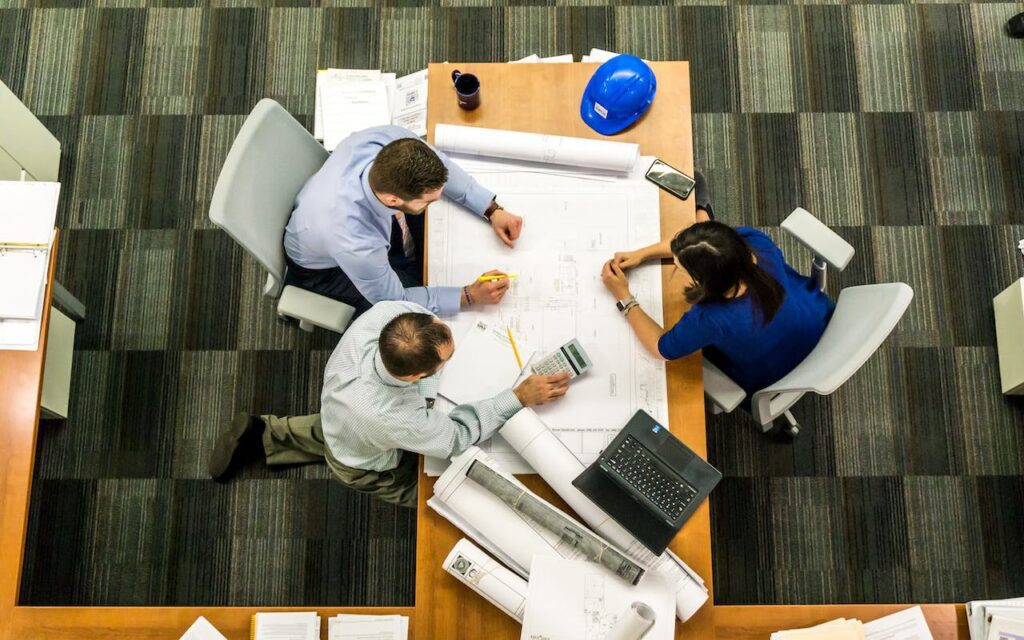Get ready to dive into the world of pre-construction planning with these 10 essential steps that are absolute game-changers. Imagine laying down the foundation for your dream home or a groundbreaking project without missing a beat. From nailing down budgets to selecting the perfect location, each step is crucial in ensuring success.
In today’s fast-paced construction industry, staying ahead means mastering these key elements early on. By following this guide, you’ll be equipped with the knowledge and strategies needed to navigate through the complexities of pre-construction like a pro. So, let’s roll up our sleeves and get started on this exciting journey towards turning your vision into reality.
Understanding Pre-Construction In Construction Projects
Importance Of Pre-Construction Planning
Pre-construction planning is the bedrock of any construction project. It involves crucial tasks like budgeting, setting project goals, and defining timelines. This phase lays the groundwork for a successful construction venture by ensuring that all aspects are meticulously planned out. During this stage, decisions are made regarding feasibility studies, design concepts, and resource allocation.
Efficient pre-construction planning can save time and money in the long run. By thoroughly assessing the project’s requirements upfront, you can identify potential issues early on and address them proactively. This proactive approach helps prevent costly delays or changes during the actual construction phase. Moreover, it allows for better coordination among stakeholders involved in the project.
Key Steps In Pre-Construction Planning
- Initial Project Assessment:
- Conduct a thorough evaluation of the proposed project site.
- Identify any environmental constraints or zoning regulations that may impact construction.
- Feasibility Study:
- Analyze if the proposed project aligns with budgetary constraints.
- Evaluate if there are any technical challenges that need to be addressed before proceeding further.
- Budget Development:
- Create a detailed budget outlining all projected costs.
- Allocate funds for each aspect of the construction process, including materials, labor, permits, etc.
- Design Conceptualization:
- Collaborate with architects and engineers to develop initial design concepts.
- Ensure that designs meet both aesthetic requirements and functional needs of the project.
- Value Engineering:
- Explore cost-effective alternatives without compromising quality.
- Optimize resources to maximize efficiency while minimizing expenses.
- Project Scheduling:
- Develop a comprehensive timeline outlining key milestones. – Coordinate with subcontractors and suppliers to ensure timely delivery of materials & services.
Importance Of Pre-Construction Planning
Maximizing Project Success
Pre-construction planning, the foundation of any construction project, is crucial. It ensures that every detail is carefully considered before breaking ground. This process involves evaluating all elements comprehensively to prevent unexpected issues during construction. By taking the time to plan meticulously, you can avoid costly mistakes and delays later on.
Proper pre-construction planning is like creating a roadmap before embarking on a journey. Just as you wouldn’t start a trip without knowing your destination or route, beginning construction without thorough planning can lead to confusion and setbacks along the way. Imagine starting a road trip with no GPS or map; you might take wrong turns, encounter dead ends, or get lost altogether.
Mitigating Risks And Enhancing Efficiency
One key benefit of pre-construction planning is risk mitigation. By identifying potential challenges early on in the process, such as site limitations or material shortages, teams can develop strategies to overcome these obstacles proactively. This foresight helps keep projects on track and within budget by minimizing unexpected expenses and delays.
Let’s consider an example: during pre-construction planning for a new office building, the team discovers that local zoning regulations restrict building height in certain areas of the site. By uncovering this limitation ahead of time, they can adjust their design accordingly to comply with regulations from the start rather than having to backtrack during construction—a cost-saving measure that also streamlines the project timeline.
Defining The Project Scope In Pre-Construction
Importance Of Defining Project Scope
Defining the project scope in pre-construction is crucial as it sets clear boundaries for what will be accomplished. By outlining the objectives, deliverables, and constraints early on, all stakeholders understand what needs to be achieved. This clarity helps prevent misunderstandings and ensures that everyone involved is working towards a common goal. Without a well-defined project scope, there can be confusion about project requirements, leading to delays and budget overruns.
A precise project scope also aids in managing resources effectively. When all team members are aware of their responsibilities from the outset, they can allocate resources efficiently, preventing unnecessary wastage. Moreover, by clearly defining what is included in the project scope, it becomes easier to identify any additional work that falls outside these boundaries—helping to avoid scope creep.
Communication And Alignment Among Stakeholders
One significant advantage of defining the project scope during pre-construction is improved communication among stakeholders. When everyone understands the project’s objectives and limitations upfront, it fosters open dialogue throughout the construction process. Effective communication ensures that any changes or challenges can be addressed promptly without derailing progress.
Setting a clear project scope aligns expectations across all parties involved—owners, designers, contractors—creating a shared understanding of what success looks like for the project. For instance:
Selecting Suitable Contractors For Construction Projects
Evaluating Qualifications, Experience, And Track Record
Selecting suitable contractors for construction projects during pre-construction planning is crucial. Evaluating their qualifications, experience, and track record is essential. This step ensures that the chosen contractors have the necessary expertise to handle the project effectively.
Thoroughly examining a contractor’s qualifications involves checking their licenses, certifications, and training. Experience in similar projects demonstrates their ability to tackle challenges specific to your construction needs. Moreover, reviewing a contractor’s track record by assessing past projects can provide insight into their work quality and reliability.
Pros:
- Ensures skilled professionals on the project
- Increases the likelihood of quality workmanship
Cons:
- Time-consuming process
- May require additional resources for thorough evaluation
Building A Reliable Team
Choosing the right contractors guarantees that your construction project will be in capable hands. By vetting contractors during pre-construction planning meticulously, you are essentially building a reliable team that can meet all project requirements efficiently.
When selecting contractors based on qualifications and experience, you are establishing a foundation for success in your construction venture. A well-rounded team with diverse skills can contribute positively to different aspects of the project lifecycle.
- Look at examples from previous projects.
- Consider testimonials or reviews from past clients.
- Evaluate how well they understand your specific needs.
- Check if they have successfully completed similar projects before.
Cost Estimation And Control In Preconstruction
Importance Of Cost Estimation
Accurate cost estimation is crucial in preconstruction to predict expenses and stay within budget. It helps allocate resources efficiently, preventing financial surprises during the construction phase. For instance, when estimating costs for a new building project, factors like materials, labor, permits, and equipment must be considered.
Effective cost estimation ensures that the project’s financial aspects are well-planned from the start. By accurately forecasting expenses upfront, it becomes easier to adjust plans or make changes before construction begins. This proactive approach can prevent delays or disruptions due to unexpected costs later on.
Implementing Cost Control Measures
Cost control measures during preconstruction are essential to maintain the project’s financial viability and profitability. These measures involve monitoring expenses closely throughout the planning phase to ensure they align with the estimated budget. One example of a cost control measure is setting up regular budget reviews with contractors and suppliers.
Construction Scheduling Essentials
Detailed Timeline
Creating a detailed timeline for each phase of the construction project is crucial in preconstruction planning. This involves outlining the sequence of tasks, setting start and end dates, and allocating resources effectively. For instance, breaking down activities like site preparation, foundation work, framing, plumbing, and electrical installations into specific timeframes ensures smooth progress.
A well-structured construction schedule plays a vital role in coordinating various activities throughout the project. By establishing clear timelines for tasks such as material deliveries or inspections within each phase of construction, teams can align efforts efficiently. For example, scheduling concrete pouring after formwork installation prevents delays and optimizes workflow.
Effective Project Management
Developing an achievable construction schedule during preconstruction is fundamental to effective project management. It allows stakeholders to allocate resources appropriately based on task deadlines and dependencies. Moreover, having a realistic timeline enables proactive problem-solving when unexpected issues arise. For instance, if weather conditions delay exterior work beyond the scheduled timeframe, adjustments can be made without compromising overall completion dates.
Pros:
- Facilitates coordination among different teams
- Helps in identifying potential bottlenecks early on
Cons:
- Overly ambitious schedules may lead to unrealistic expectations
- Inaccurate estimations can result in delays
Procurement Of Materials In Preconstruction
Importance Of Material Procurement
Efficient procurement of materials in preconstruction is crucial for a successful project. Identifying the necessary materials, sourcing reliable suppliers, and ensuring timely delivery are essential steps. Without proper planning, projects can face delays, cost overruns, and quality issues during construction. For instance, if key materials are not available when needed due to poor procurement planning, it can halt progress and lead to additional expenses.
Proper material procurement planning optimizes project progress by guaranteeing that all required resources are on-site as needed. This ensures a seamless workflow without unnecessary interruptions or setbacks. By having a well-thought-out plan for material procurement before construction begins, teams can streamline operations and maintain momentum throughout the project timeline.
Strategies For Efficient Material Procurement
- Identify Required Materials: Start by creating a detailed list of all materials needed for the project based on the construction plans.
- Source Reliable Suppliers: Research and establish relationships with reputable suppliers who can provide high-quality materials within specified timelines.
- Ensure Timely Delivery: Coordinate with suppliers to schedule deliveries according to the project timeline to avoid any delays in construction activities.
- Consider Lead Times: Factor in lead times for ordering materials to prevent last-minute shortages that could impact the project schedule.
- Quality Control: Implement processes to verify the quality of procured materials to avoid using substandard products that could compromise structural integrity.
Ensuring Safety In Construction Projects
Identifying Potential Hazards
Identifying potential hazards during preconstruction is crucial. This involves assessing the site for risks like uneven terrain, unstable structures, or hazardous materials. By recognizing these dangers early on, safety measures can be put in place to prevent accidents.
It’s essential to involve all stakeholders in hazard identification. For example, consulting with engineers and architects can help pinpoint structural vulnerabilities, while speaking with workers who will be on-site daily can reveal potential risks unique to their tasks.
Implementing Safety Protocols
Implementing safety protocols ensures that everyone involved follows established safety guidelines. These protocols may include wearing personal protective equipment (PPE), adhering to specific procedures when operating machinery, and maintaining a clean and organized work environment.
Regular safety inspections should also be conducted throughout the preconstruction phase to address any new hazards that may arise. By consistently enforcing safety protocols, the risk of accidents decreases significantly.
Providing Training To Workers
Providing training sessions for workers on safety practices is vital. This includes educating them about proper lifting techniques, emergency procedures, and how to use safety equipment correctly. Well-trained workers are more likely to identify potential hazards and mitigate risks effectively.
Training should not be a one-time event but an ongoing process throughout the project duration. Regular refresher courses can reinforce safety practices and ensure that all workers remain vigilant about maintaining a safe working environment.
Anticipating And Addressing Potential Problems
Thorough Risk Assessments
Identifying potential problems in the early stages of preconstruction is crucial for a successful project. Conducting thorough risk assessments helps uncover possible challenges that may arise during construction. By identifying risks such as budget constraints, design flaws, or material shortages, project managers can develop strategies to mitigate these issues before they escalate.
Developing contingency plans based on the findings of risk assessments is essential to ensure smooth project progression. These plans act as safety nets when unexpected hurdles emerge. For instance, if there’s a possibility of delays due to unfavorable weather conditions, having backup schedules in place can help keep the project on track.
Proactive Problem-Solving
Addressing potential problems proactively during preconstruction prevents them from snowballing into major setbacks later on. Proactive problem-solving involves brainstorming solutions for identified risks and establishing protocols to handle unforeseen circumstances swiftly and effectively.
By anticipating challenges like permit delays or site access restrictions beforehand, construction teams can create alternative approaches to keep the project moving forward without significant interruptions. This foresight not only saves time but also reduces costs associated with resolving issues that could have been prevented earlier.
Project Resilience
Enhancing project resilience through effective preconstruction planning increases its chances of success. When potential problems are anticipated and addressed promptly, projects become more adaptable to changing conditions and unforeseen events throughout their lifecycle.
Project resilience allows construction teams to navigate uncertainties confidently while staying aligned with timelines and budgets. For example, by foreseeing supply chain disruptions or labor shortages in advance, proactive measures can be taken to secure alternative suppliers or adjust work schedules accordingly.
Pros:
- Minimizes disruptions during construction.
- Enhances adaptability to changing conditions.
Cons:
- Requires additional time investment upfront.
- May involve extra costs for developing contingency plans.
Closing Thoughts
You’ve now got the lowdown on pre-construction planning essentials. Remember, it’s not just about laying the groundwork; it’s about setting the stage for a blockbuster construction performance. From scoping out the project to nailing down costs and schedules, each step is like a puzzle piece coming together to reveal the big picture.
So, roll up your sleeves, get your hard hat on, and dive into pre-construction like a pro. Missing any of these steps could be like trying to build a house without a foundation – a recipe for disaster. Take charge, follow these steps diligently, and watch your construction projects soar to new heights!
Frequently Asked Questions
1. What Is The Significance Of Pre-Construction Planning In Construction Projects?
Pre-construction planning sets the foundation for project success by defining scope, estimating costs, scheduling tasks, and ensuring safety measures. It helps identify potential issues early on to streamline the construction process effectively.
2. How Does Cost Estimation Play A Crucial Role In Preconstruction Planning?
Cost estimation allows project stakeholders to allocate resources efficiently, prevent budget overruns, and make informed decisions throughout the construction phase. Accurate cost estimates help maintain financial control and ensure project feasibility.
3. Why Is It Essential To Select Suitable Contractors During Pre-Construction?
Choosing reputable contractors ensures quality workmanship, adherence to timelines, and overall project success. Working with experienced professionals minimizes risks of delays or subpar construction outcomes, contributing to a smoother building process.
4. What Are The Key Elements Involved In Defining The Project Scope During Pre-Construction?
Defining the project scope involves outlining objectives, deliverables, constraints, assumptions, and success criteria. Clearly establishing these elements helps align all stakeholders on expectations and facilitates effective communication throughout the construction project lifecycle.
5. How Can Proactive Safety Measures Enhance Construction Projects During Preconstruction Planning?
Implementing robust safety protocols not only protects workers but also prevents accidents that can lead to costly delays or legal liabilities. Prioritizing safety from the outset fosters a culture of responsibility and promotes an environment conducive to successful project completion.
Optimize Your Project’s Success With Pre-Construction Planning By Red White & Blue Construction!
Embarking on a construction project in Lafayette, CA? Look no further than Red White & Blue Construction for expert pre-construction planning services! Specializing in laying the groundwork for successful construction projects, we tailor our pre-construction strategies to meet your specific project goals. Renowned for our expertise in pre-construction planning, we are committed to ensuring your project’s vision is meticulously planned and prepared for, whether it’s a residential, commercial, or community initiative. Our reputation across the Bay Area speaks to our dedication to precision, quality, and the exceptional standards we uphold in every phase of planning.
At Red White & Blue Construction, we do more than just prepare; we set the foundation for your project’s success. With our comprehensive planning, transparent pricing, and exceptional client service, you’re not just planning a construction project; you’re setting the stage for a seamless, efficient build. Choose Red White & Blue Construction for your pre-construction planning needs. Begin your project with confidence and contact us today!
Disclaimer
The materials available on this website are for informational and entertainment purposes only and not to provide advice. You should obtain advice concerning any particular issue or problem from a professional. You should not act or refrain from acting based on any content included in this site without seeking legal or other professional advice. The information presented on this website may not reflect the most current building developments. No action should be taken in reliance on the information on this website. We disclaim all liability concerning actions taken or not taken based on any or all of the contents of this site to the fullest extent permitted by law.





